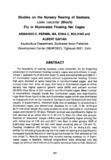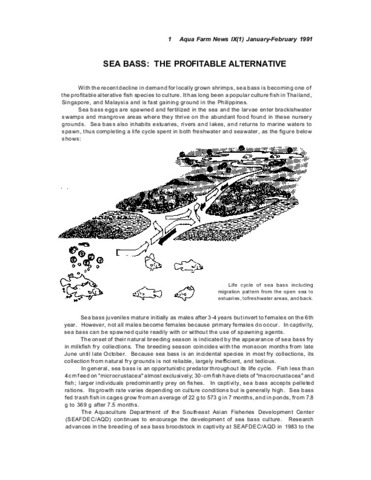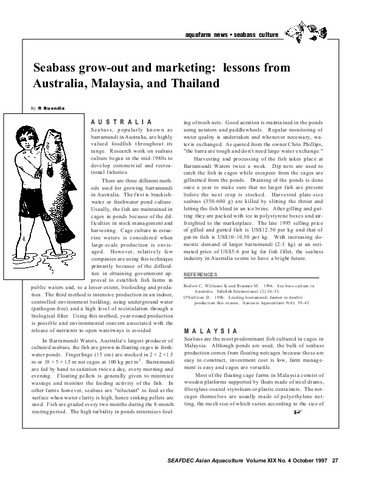Studies on the nursery rearing of seabass, Lates calcarifer (Bloch) fry in illuminated floating net cages
- Global styles
- MLA
- Vancouver
- Elsevier - Harvard
- APA
- Help
Share
นามธรรม
The feasibility of rearing seabass, Lates calcarifer, fry for fingerling production in illuminated floating nursery cages was determined. In experiment 1, seabass fry of 20.0 mm mean TL were stocked at 600 and 1200 in 1 m3 illuminated cages and reared without supplemental feeding. Control fish were stocked at same densities in non-illuminated cages and fed minced trash fish. After 42 days, fish held in illuminated cages at either density had higher specific growth rates (SGR) and percent survival (20-38%) than those of fish reared in non-illuminated cages. Mean number of zooplankton trapped inside the illuminated cages was significantly higher than those found in the non-illuminated cages which was dominated by Copepods such as the Calanoid, Cyclopoid and Harpacticoid and their nauplii. In experiment 2, minimum body size of seabass fry at stocking in illuminated cages was determined. Seabass fry of 7.35, 11.30, 18.73 and 20.71 mm total length (TL) were stocked at three replicates in illuminated cages and reared for 30 days. Percent survival was significantly higher for fish stocked at an initial size of 11.30 mm TL than the other size groups. Number of “shooters” (range = 6-9%) was significantly higher among fish with initial size of 7.35 mm and 20.71 mm than in other groups. SGR of 8.28%/day was highest for fish with mean stocking size of 7.35 mm TL. Feeding incidence (FI) ranging from 13.16 ± 6.7% to 54.9 ± 4.2% was similar for all size groups during the first week of rearing and significantly increased towards the end of rearing period except for fish stocked at 7.35 mm initial TL. Results showed that nursery rearing seabass fry in illuminated cages is feasible. Natural zooplankton were attracted into the cages by artificial illumination sufficiently served as food to fish. Minimum stocking size of seabass fry is from 10-15 mm TL for better survival. Early transfer of fry in nursery cages and availability of natural zooplankton through artificial illumination can be a cost-effective method of nursing seabass fry.
การอ้างอิง
Fermin, A. C., Bolivar, M. E. C., & Gaitan, A. (1994). Studies on the nursery rearing of seabass, Lates calcarifer (Bloch) fry in illuminated floating net cages. In S. A. Al-Thobaiti, H. M. Al-Hinty, A. Q. Siddiqui, & G. Hussain (Eds.), Aquaculture Technology and Investment Opportunities. Proceedings of the First International Symposium on Aquaculture Technology and Investment Opportunities, 11-14 April 1993, Riyadh, Saudi Arabia (pp. 187-199). Riyadh, Saudi Arabia: Ministry of Agriculture and Water; King Abdulaziz City for Science and Technology; Riyadh Chamber of Commerce and Industry.
Type
Conference paperคอลเลกชัน
- Conference Proceedings [299]
Related items
Showing items related by title, author, creator and subject.
-
Sea bass: The profitable alternative
Southeast Asian Fisheries Development Center, Aquaculture Department (Aquaculture Department, Southeast Asian Fisheries Development Center, 1991) -
Seabass grow-out and marketing: lessons from Australia, Malaysia, and Thailand
Buendia, Romeo (Aquaculture Department, Southeast Asian Fisheries Development Center, 1997) -
Culture of grouper, sea bass and red snapper
Toledo, Joebert D. (University of the Philippines Aquaculture Society, Inc., 2001)Marine fish production has increased dramatically in the past ten years and majority of the cultured species were produced in Asia in 1992. Increase in production was accompanied with concerns on increasing outbreak of ...






